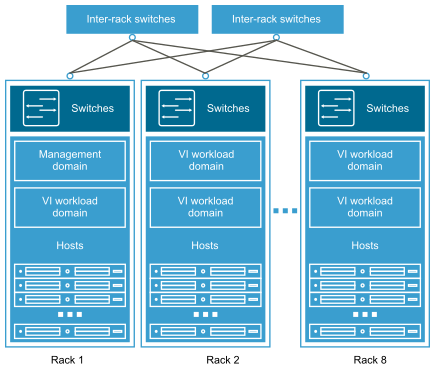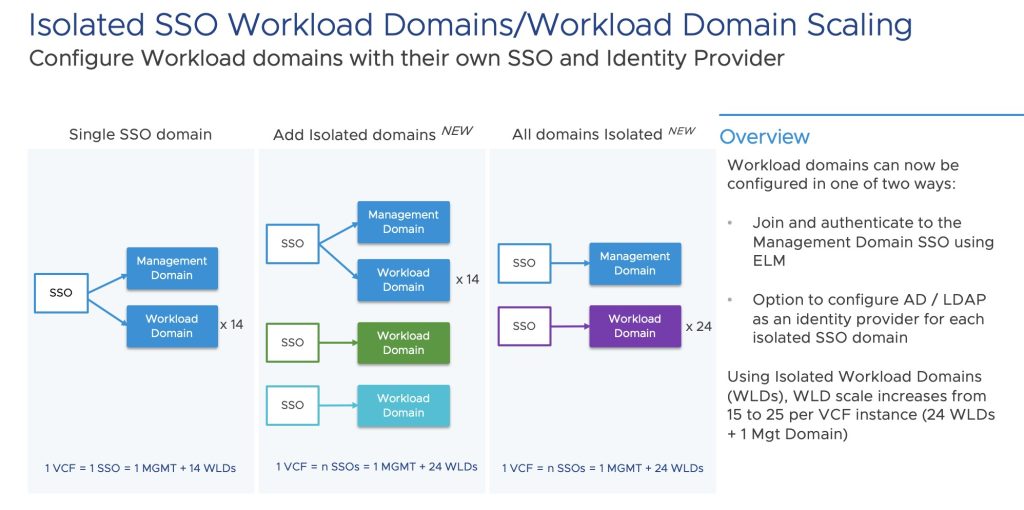It is our pleasure to announce that VMware Cloud Foundation 5.0 is now available for our Cloud Services Providers. This announcement complements the VMware Cloud Foundation 5.0 product launch earlier this month, providing access to all of the features and capabilities available in that release to our Cloud Services Provider community.
VMware Cloud Foundation 5.0 continues to deliver enterprise-level enhancements that customers require, including additional scalability, performance, security, and manageability features for their virtual and cloud-native application workloads. This release captures all of the latest releases available, including:
- VMware SDDC Manager 5.0
- ESXi 8.0 U1
- vCenter Server 8.0 Update 1
- vSAN 8.0 Update 1
- Aria vRealize Suite Lifecycle Manager 8.10 Patch 1
- NSX 4.1
- Tanzu Kubernetes Grid 2.0
Our Cloud Services Providers can now take advantage of several important capabilities with this release.
Support for the Standard Architecture Model
With VMware Cloud Foundation 5.0, Cloud Services Providers are now able to take advantage of the standard architecture model, where management workloads run on a dedicated management domain and tenant workloads are deployed in separate virtual infrastructure (VI) workload domains. This model is recommended because it separates the partner management workloads from its customer tenant workloads, and provides better scale and flexibility as the environment grows. With a separate vCenter Server in each domain, partners can achieve better security, scalability, licensing, and lifecycle management.

Prior to this release, Cloud Services Providers could only provision workloads with the consolidated architecture model, where management and workloads were shared in the management domain. This was previously discussed in last year’s blog and vmLIVE.
Support for Isolated SSO Workload Domains
VMware Cloud Foundation 5.0 includes a new capability called Isolated SSO Workload Domains. Cloud Services Provider administrators now have the option to configure new workload domains using a separate Single Sign On (SSO) instance. This scenario is useful for Cloud Services Providers that need workload isolation or want to allocate workload domains to different tenants with their own SSO domains. Isolated SSO domains are each configured with their own NSX instance. The added benefit is that configuring workload domains as an isolated workload domain also allows the option to configure a separate identity provider (Active Directory or LDAP).

Expanded AI/ML Workload Support
VMware Cloud Foundation 5.0 supports the latest GPU virtualization innovations. With the support of the NVIDIA AI Enterprise Suite, NVIDIA Ampere A100 and A30 GPUs can now be configured with VMware Cloud Foundation to support AI/ML workloads. VMware, in partnership with NVIDIA, has integrated the latest virtual GPU (vGPU) capabilities enabled by vSphere, into VMware Cloud Foundation 5.0. Cloud Services Providers can now extend their software-defined private or sovereign cloud platforms to support a flexible and easily scalable AI-ready infrastructure.
Scalability, Performance, and Manageability Updates
There are several scalability, performance, and manageability improvements with VMware Cloud Foundation 5.0. While you can read about them in the product blogs for each of the VCF core products, here is a quick summary of the major enhancements which Cloud Services Providers will find useful:
- VMware Cloud Foundation can now support up to 25 workload domains per deployment, allowing for greater scale to match tenant growth needs.
- vSphere 8.0 Update 1 delivers support for up to 64 devices in Passthrough mode per VM to achieve unparalleled levels of performance. You can now support higher complexity models by increasing available GPU resources.
- Additionally, vSphere 8 Update 1 dramatically speeds up AI/ML application performance with support for NVIDIA NVSwitch (up to 900GB/s bidirectional speed with NVLink on Hopper), which connects up to 8 GPUs per host and up to 8 GPUs to the same VM.
- vSphere 8 now supports 8 vGPUs per VM. vSphere Distributed Resources Scheduler (DRS) now factors workload memory usage into placement decisions. DRS can now place workloads optimally by taking into consideration memory needs of workloads and by factoring in DRAM & PMEM bandwidth and latency requirements.
- vSAN 8 Update 1 Performance Service now includes high-resolution monitoring of performance metrics. Default collection intervals for performance metrics—previously rendered every minute—are now collected every 30 seconds. This allows for real-time analysis of performance, simplifying monitoring and accelerating the ability to troubleshoot.
- NSX 4.1 delivers multi-tenancy for networking resources and NAPP 4.0.1.1 support
- NSX 4.1 introduces new container networking and security enhancements, which allows firewall rules to be created with a mix of VMs and Kubernetes Ingress/egress objects.
- Aria Operations for Logs has been enhanced to bring stronger data depth and context with features such as Log trend analysis, filter support for advanced troubleshooting, log widget in dashboards and logging fields support for log messages.
- Aria Operations offers complete 360-degree troubleshooting that combines metrics, logs and numerous integrations. Webhooks page is enhanced to provide a consistent workflow such as Alert definitions and reports.
Additional Resources
Here are some resources available to further detail VMware Cloud Foundation 5.0 capabilities:
- [BLOG] Announcing VMware Cloud Foundation 5.0
- [BLOG] What’s New with vSphere and vSAN in VCF 5.0
- [BLOG] What’s New with NSX in VMware Cloud Foundation 5.0
- [BLOG] What’s New with vRealize Suite in VMware Cloud Foundation 5.0
- VMware Cloud Foundation 5.0 Release Notes
- VMware Cloud Foundation Product Page
- VMware Cloud Foundation Technical Resources
- VMware Cloud Foundation with Tanzu Datasheet
- VMware with Tanzu Solution Brief
- Partner FAQ



